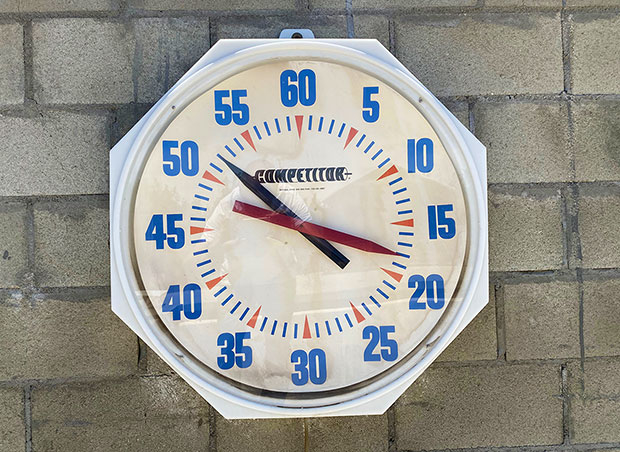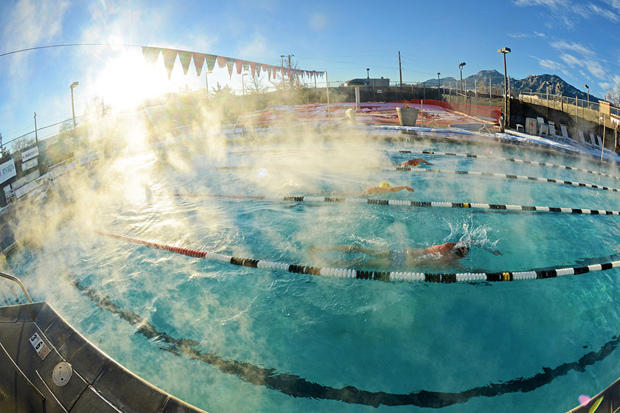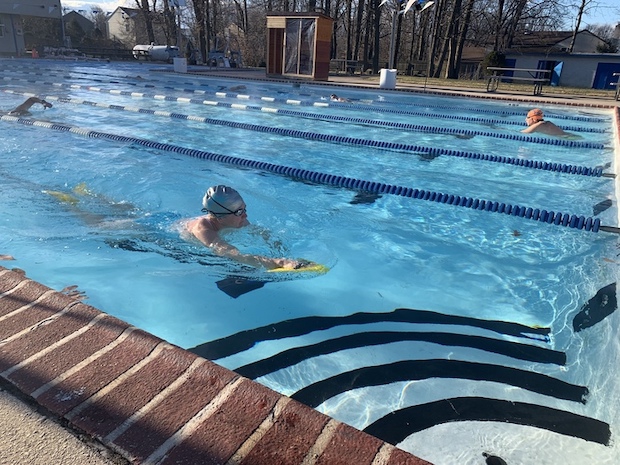The Leave Interval

We’re about to commence the Guppy Challenge (no charge, sign up here, which will begin on Monday upcoming, June 6th, and last for 12 weeks. If you want to improve your swim this is the time when everybody in the Slowtwitch posse will carve out time to help you get faster, safer, more efficient, more confident.
But let’s get the purpose of what I’m writing about today, which is the leave interval. This is a term of art in swimming, and it refers to the allotted time given for the swim + the rest during a set. Let’s talk about what this is; why this is; why you need to know your leave interval for the Guppy Challenge; and how the leave interval has made its way into popular swim culture.
Indeed, if you arrive at a master’s (or any) swim team with which you’ll swim, and with whom you’re unfamiliar, the coach (or someone) will clue you in. Lane 1 is for the speed merchants and that lane might be referred to as, say, the 1:15 lane (the one-fifteen lane). Lane 2 might be the 1:20 lane, then the 1:25, the 1:30, 1:40 lane and so on. This nomenclature refers to the leave interval, and while the leave interval may vary per lane throughout the workout, depending on the purpose of the set, you might safely say that you determine what your leave interval is by figuring out how much time you need to swim 10x100yd (10 repeats of a 100-yard swim) with, say, 8 to 12 seconds rest. If you can swim 10 times 100 yards, leaving every 1:30, coming in at 1:20 and resting 10 seconds before commence another swim, you’re a pretty good bet for the 1:30 lane.
And I think I just described what the leave interval means: It’s the total time it takes to swim the distance of 1 element in the set plus the time it takes you to rest up before you commence swimming the next element in the set.
What’s the point of this? I mean, when I ran track in high school we didn’t do it this way. We had “prescribed rest.” If we ran, say, 12x440yd on the track (it was 440 yards in my day, not 400 meters), we either rested for a given period of time in between each 440yd (we rested for 1 minute or 2 minutes); or we jogged a lap around the track in between each 440 (which typically took us 2:30). Not in running or cycling or in any other sport is there a leave interval. Why so in swimming?
Pool Clock
Two reasons for this, each equally to “blame.” First is the pool clock. Whether it’s a clock with a moving second hand (like that one pictured above, timing Monty’s pool at The Slowtwitch Compound), or a digital clock, it’s too hard to keep track of your swim set if you’re giving yourself a prescribed rest. Hearken back to that 10x100yd set. If you arrive to the wall in 1:18, and your prescribed rest is 10sec, you leave at 1:28 and come in at, say, 2:55. Then you leave at 3:05 and come in at 1:26; leave at 1:36 and come in at 4:28; leave at 4:38. Well, you can do it. But it’s just easier on the brain to know that every time you touch the wall you’re either leaving on the “top” or the “bottom.”
Let’s stop there for a moment. What does leaving on the “top” mean? It means you leave at double-zero, 12 o’clock. Leaving on the bottom means you’re leaving at 6 o’clock. This comes from the days before digital clocks, and the second hand of that large-face pool clock either pointed up, to the top, high noon, or it pointed straight down to 6 o’clock. So in swimming parlance we leave on the top, on the bottom, on the :15, on the :20, and these all refer to places on the clock.
If you leave on the 3:20 – and this might be the case if you swim repeat 200s, and you’re reasonably good adult onset swimmer – this means you’ll swim your 200yd in 3min, which is, again in swim parlance, “at 1:30 pace,” and by that we mean you’re swimming your 200s at a clip of 1min30sec for every 100. If you swim 1000yd at 1:30 pace you’ll complete that swim in 15min. Get it? Anyway, back to our repeat 200s: If you have to hoof it pretty good to swim your 200yd swim in 3min, and if you have to do 10 or 12 of these, you’ll need a reasonable rest. Say, 20sec. So, you’ll leave “on the 3:20.” This means you’ll finish your 200yd swim in 3min, rest for 20sec, and leave “on the :20” which is pronounced “on the twenty.” After your second 200yd swim, you’ll leave on the :40.
You commenced your first 200 “on the top,” you left on the :20 for your 2nd 200, on the :40 for your 3rd 200, and for your 4th 200 you’re back leaving on the top. The comforting thing about the leave interval is that you always know, after every 200, that you’re leaving on the :20, on the :40, or on the top. Because you became brain-addled during a workout, I promise you’ll lose track of where you are sometime during that set, but 2 things you can remember: You’ll know that you always have around 20sec rest after you hit the wall, and you’ll always leave at one of those 3 places on the clock. The leave interval helps you keep track of things.
Lane Management
The second reason for the leave interval has to do with team dynamics. On a busy, active Masters team you might have 7 people in a lane in a short course yards (25 yard) pool. You can’t have people swimming pell mell all over the pool, passing each other, colliding into oncoming traffic. The leave interval helps coaches manage the lanes in his or her pool.
For the purpose of the Guppy Challenge, it’s helpful to determine what your leave interval is or should be for the various sets you’ll get. Very roughly, what I would like to see from you all is about 10sec to 20sec rest per 100yd. Sometimes more rest, sometimes less, depending on the purpose of the set. Sometimes there’ll be more like :30 or :40 rest between 100s if the purpose is to build raw speed. But if you were able to swim 10x100yd as fast as you could, leaving on the 1:45, and swim all 10 of those 100yd swims in 1:30 (leaving you 15sec rest between each 100) then I think that’s a pretty good indicator that you’re a candidate for the 1:45 lane (or maybe the 1:40 lane if you’re ambitious).
When we say “20sec rest” in our written workout, what we mean, really, is a leave interval that will grant you about 20sec rest. But there is one exception to leave intervals.
Many Slowtwitchers swim with the FORM goggle. In our Guppy Challenge you can get your workouts 2 ways: from me, here, on Slowtwitch; or downloaded into your FORM goggle. If you get your workouts that second way, FORM gives you a prescribed rest. FORM does the calculating for you; it knows when you’ve arrived at the wall and it tells you when to leave. When it says 20sec rest, you get 20sec rest. Therefore, the leave interval paradigm is necessary for those who’re using typical goggles and who use a pool clock or a watch.




